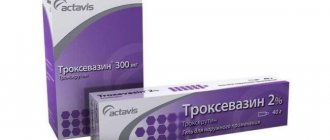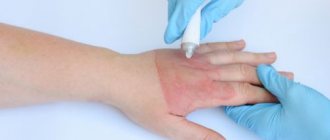What is Troxevasin
A medicine based on the angioprotective active substance troxerutin. Regulates the tone of capillary vessels and veins. It is used to eliminate pain, swelling and trophic disorders caused by their dysfunction.
Troxevasin is produced:
- in the form of an ointment for topical use: a viscous yellowish gel-like mass containing 2% troxerutin, packaged in 40 g tubes;
- in the form of capsules for oral administration: in a dosage of 300 mg of the active substance, gelatin, in blisters.
The product has a pronounced venoprotective effect. It helps reduce the permeability of vascular walls, improves blood outflow, prevents its stagnation in the lower extremities, prevents thrombus formation and the development of inflammatory processes. Troxevasin alleviates the underlying symptoms of varicose veins and slows down its progress.
Reviews about the drug
Patients and specialists leave approximately the same reviews about the two dosage forms of the drug. Most patients note the high effectiveness of the drug for bruises, hemorrhoids and varicose veins.
Doctors also note positive results in the treatment of patients with the above pathologies.
Negative reviews are most often found when patients self-medicate and want to get rid of varicose veins only with the help of Troxevasin. Relief of the symptoms of this disease is possible only with complex, competent treatment in combination with the use of other drugs, elastic compression, diet, proper daily routine and adherence to work and rest.
What is Troxevasin used for?
Medicinal ointment and capsules are prescribed:
- for chronic venous insufficiency;
- lack of nutrition of soft tissues caused by varicose veins;
- with postphlebitic syndrome;
- trophic ulcers;
- for symptoms of hemorrhoids;
- with retinopathy against the background of hypertension and diabetes.
The drug is used to prevent complications after surgical treatment of varicose veins, to prevent further vascular damage in the initial stages of pathology. Troxevasin is also indicated to improve well-being after mechanical injuries: bruises or sprains.
The active substance from the capsules is absorbed in the intestines. Its maximum concentration in the blood is observed 1.5–2 hours after administration. Metabolized by the liver and completely leaves the body within 0.5–1 day. Troxerutin from the ointment penetrates all layers of the epidermis, dermis and subcutaneous tissue within 3–5 hours.
Indications and contraindications for use
Dosage forms are prescribed in various clinical cases. Capsules are used for:
- chronic insufficiency of venous vessels;
- trophic disorders;
- postphlebitic syndrome;
- postoperative period for venectomy or sclerotherapy;
- hemorrhoids;
- combined atherosclerosis or hypertension with diabetes mellitus.
The gel has the following indications for use:
- varicose veins;
- chronic venous insufficiency;
- periphlebitis or thrombophlebitis;
- varicose dermatitis;
- injuries (bruises and sprains).
Contraindications to the administration of capsules:
- exacerbation of gastritis or ulcer of the stomach and duodenum;
- individual intolerance to components.
- CKD (may be prescribed with caution and under strict supervision and supervision of a specialist).
Contraindications to the use of the gel:
- individual hypersensitivity to components;
- violation of the integrity of the mucous membranes and skin.
When is Troxevasin contraindicated?
It is prohibited to take the drug orally:
- with exacerbations of ulcerative lesions of the gastrointestinal mucosa;
- some forms of gastritis;
- severe renal failure;
- increased sensitivity to the active or excipients of the drug.
The use of ointment should be avoided:
- if an allergic reaction to the drug develops: increased swelling, rash, severe burning or itching;
- with severe irritation, furunculosis, open skin lesions at the site of application of the product.
How to use Troxevasin capsules
The medicine should be swallowed with water, without chewing or crushing. Meal times don't matter. At the beginning of therapy, take 1 capsule. three times a day. Diabetic retinopathy and other severe conditions require up to 1800 mg (6 capsules) per day.
The course is continued for up to 15 days. After assessing the effectiveness of the dose, the dose is adjusted. It may increase or decrease. If the symptoms of the pathology subside, at the discretion of the doctor, therapy can be completed without a maintenance period. Otherwise, Troxevasin is taken for another 3-4 weeks.
Troxevasin capsules 300 mg No. 10x5
Name
Troxevasin caps 300 mg in blister pack No. 10x5
Description
Hard cylindrical gelatin capsules, No. 1, body – yellow, cap – yellow. Capsule contents: yellow to yellow-brown powder, the presence of conglomerates is allowed, which disintegrate when pressed.
Main active ingredient
Troxerutin
Release form
text
Dosage
300 mg
pharmachologic effect
The main component of the drug Troxevasin is troxerutin. It tones the walls of blood vessels and reduces their increased permeability. Has an anti-inflammatory effect on perivascular tissues. Thus, it reduces swelling and improves vascular nutrition during various painful changes associated with venous insufficiency.
Indications for use
Treatment (as part of complex therapy) of symptoms of venous-lymphatic insufficiency:
- heaviness in the legs;
- pain;
- swelling;
- trophic disorders.
Treatment (as part of complex therapy) of symptoms associated with acute attacks of hemorrhoids. If after 2 months you do not feel better or your condition worsens, seek help from your doctor.
Directions for use and doses
Always take this medicine exactly as described in this leaflet or as directed by your doctor. If you are unsure about anything, ask your doctor or pharmacist. Troxevasin is taken orally during meals with a sufficient amount of water. The initial dose is 1-2 capsules 3 times a day. Treatment at this dosage should be continued until objective clinical improvement (reduction of edema and other symptoms of venous insufficiency), usually within 2 weeks. Maintenance dose – 1 capsule 1-2 times a day. The course of treatment is 2-4 weeks. After the symptoms have been reduced, treatment can be stopped; if symptoms reappear, it can be carried out again according to the above-described scheme. Special categories of patients Elderly patients No dose adjustment is required. Patients with decompensated insufficiency of liver and kidney function A dose reduction is recommended. Use in children and adolescents The use of the drug in children under 18 years of age is not recommended. If you miss one dose, take it as soon as possible. If it is time for your next dose, take it as usual. Do not double the dose to make up for a missed dose, as this may increase the likelihood of adverse reactions. If you have any additional questions about taking this drug, please ask your doctor or pharmacist.
Use during pregnancy and lactation
If you are pregnant or breastfeeding, or think or are planning to become pregnant, talk to your doctor or pharmacist before using this medicine. It is not recommended to use in the first trimester of pregnancy, in the second and third trimesters of pregnancy - on the recommendation of a doctor, in cases where the benefit to the woman outweighs the potential risk to the fetus. There is no data on the use of troxerutin during breastfeeding.
Impact on the ability to drive vehicles and work with equipment
Troxevasin does not affect the ability to drive a car or use equipment.
Precautionary measures
In order for the expected therapeutic result to appear, it is necessary to strictly follow the doctor’s instructions on the dosage and duration of treatment. Long-term use is not recommended for patients with severe renal impairment. The drug is ineffective for edema due to diseases of the liver, kidneys or cardiovascular system. The drug contains lactose and is not recommended for patients with lactose intolerance, galactosemia or glucose/galactose malabsorption syndrome. Due to the presence of dyes (E 104 and E 110), treatment with the drug may cause allergic reactions, including asthma. The risk of allergies is higher if you are allergic to aspirin. In case of venous circulation disorders, the maximum effect of treatment is observed with a healthy, balanced lifestyle, while it is necessary to avoid prolonged exposure to the sun, prolonged standing, weight gain, and walking. Patients should strictly follow the additional therapeutic measures prescribed by the doctor, such as wearing compression medical hosiery (socks, stockings), compresses, cool showers on the lower extremities, etc. If abnormally severe complaints occur, especially in the condition of the legs, which are characterized by inflammation, changes in skin color, a feeling of tension or heat, lumps under the skin, pain, ulcers, thrombophlebitis, swelling of one or both legs, you should immediately consult a doctor, as These symptoms may be signs of a serious illness (lower extremity venous thrombosis). The same applies to signs of heart and kidney failure. For acute attacks of hemorrhoids, taking this drug does not replace special treatment for other diseases of the anorectal area. Treatment should be prescribed in a short course. If symptoms do not go away quickly, it is necessary to conduct a proctological examination and reconsider the therapy.
Interaction with other drugs
Tell your doctor or pharmacist if you are taking, have recently taken or may take any other medicines. There are no data on established drug interactions. The use of Troxevasin and the intake of food, drinks and alcohol There are no restrictions on the use of the drug and the intake of food and drinks.
Contraindications
Troxevasin is not used in case of hypersensitivity to troxerutin or any other component of the drug.
Compound
Active ingredient in 1 capsule: troxerutin 300 mg. Excipients: magnesium stearate, lactose monohydrate. Composition of hard gelatin capsule: quinoline (E 104), orange yellow (E 110), titanium dioxide (E 171), gelatin.
Information on excipients
Troxevasin contains lactose and E110. Patients with rare hereditary problems such as galactose intolerance, Lapp lactase deficiency or glucose/galactose malabsorption should not take this medicine. Dye (E110) may cause allergic reactions.
Overdose
There have been no cases of drug overdose. In case of taking very high doses or if serious adverse reactions occur, treatment with Troxevasin is stopped and symptomatic treatment is prescribed.
Side effect
Like all medicines, this drug may cause side effects, although not everyone gets them. When treated with troxerutin capsules, adverse reactions are rare (may affect up to 1 in 1,000 people) or very rare (may affect up to 1 in 10,000 people). From the immune system Very rare: anaphylactic shock, anaphylactoid reactions, hypersensitivity reactions. Symptoms disappear quickly after discontinuation of the drug. From the nervous system: Very rare: dizziness, headache. From the vascular system Very rarely: “hot flashes”. From the gastrointestinal tract Rarely: gastralgia, gastric discomfort, dyspepsia, flatulence, diarrhea. From the skin and subcutaneous tissue Rarely: rash, itching, urticaria. General disorders and effects at the site of application Very rare: fatigue. If any side effect becomes serious or you experience side effects not described in this leaflet, please contact your doctor or pharmacist.
Storage conditions
At a temperature not higher than 25°C. Keep out of the reach of children!
How to use Troxevasin ointment
The drug is used externally: on clean skin over the lesion. A small amount of ointment is distributed over the body area in a thin layer, lightly rubbing it in until completely absorbed. After application, you can leave the skin open or apply fixing bandages, bandages, and put on compression stockings and bandages if necessary.
The procedure for applying the medicine is repeated twice a day: in the morning and in the evening. If this is not enough, do it more often. There is no need to specifically rinse off any remaining drug before applying again. The duration of treatment with ointment is up to 7 days. If there is no result or the physical condition worsens, the medicine is discontinued and another method of therapy is chosen.






